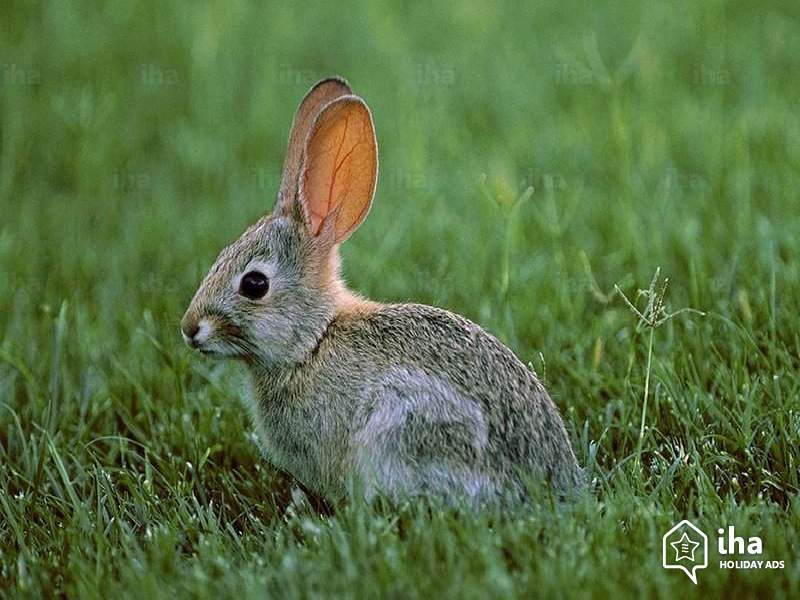Legal Status
None
Key Identification Features
Fur colouration in rabbits varies from brown to sandy and black with the underbelly a light greyish tint. Adult males known as bucks weigh in at up to 2kg with the females known as does being slightly smaller and lighter averaging 1.5kg. Total head and body length is about 50cm in fully grown adults which includes a small fluffy tail under 10cm long. Rabbits have unusually large hind legs compared to their front legs and over all body size. The movement style is a characteristic hoping motion which can change to a fast gallop when being pursued. They have large prominent eyes which allow them to scan for predators in a near 360-degree range. They have excellent senses of smell and hearing which utilize their long narrow ear design. They are usually a non vocal species but will omit loud distress calls when threatened. Rabbit tracks are grouped together in distinctive clusters of four prints ranging from six to nine centimeters in length leaving a Y-shaped trail. The fore foot contains five toes although only four will appear in a footprint, the larger hind foot has four toes leaving tracks which are smaller but very similar to that of the brown hare species.
Habitat
A resident in Ireland since the 12th century rabbits now occupy a variety of habitats including open grassland, heath land, meadows, fringes of agricultural lands, grassy cliffs, sand dunes and light deciduous woodlands. There are only a few habitat areas in Ireland which are unsuitable for rabbits to colonize which include coniferous forest, exposed mountainous regions and wetlands. Rabbits usually live in large social groups in underground tunnels known as warrens that they excavate in areas of soft dry soil which are comprised of numerous interlinked chambers. Individuals may forage up to 400 meters from the warren and may be found even further away in areas of poor quality habitat or where the population density is low. Rabbits require habitats of short grasses in close proximity to secure cover areas like hedgerows and bramble patches which they use to hide from predators. Home ranges of individuals will vary depending on the habitat’s quality with males ranging further than females within an area up to 2ha2, home range size is linked to the population density of the area with higher numbers of rabbits resulting in smaller home ranges for individuals. A male’s territory usually overlaps with the home range of several breeding females. Reproductive suppression within a warren can occur if the population reaches a density of 25 to 100 individuals per hectare.
Food and Feeding Habits
Rabbits are herbivorous with sharp teeth that can grind grasses from side to side and forwards and backwards, teeth re grow throughout their lives as they continually become worn. Rabbits are highly adaptive feeders and will consume different types of vegetation as it is available in different habitat types usually consisting of grasses, leaves and herbage. As the rabbit’s food source is difficult to digest they may re-eat their soft droppings again in order to gain more nutritional value, this practice is known as refrection. If available, rabbits will feed on agricultural crops like cereals and root crops, tree seedlings and saplings especially in winter when natural grass growth is reduced. Rabbits are mainly nocturnal grazers with a peak in feeding activity occurring at dusk and dawn.
Reproduction and Life Cycle
The main breeding season for rabbits in Ireland extends from January to August but they can breed at any time during the year. Three to seven litters per year can be produced by each breeding female with the average litter size being five to ten kittens each. Pregnancy lasts for 30 days with the kittens born furless and blind weighing only 50 grams usually in underground nesting chambers in the warren. Low ranking does will dig a small burrow known as a stop where the kittens will remain to be visited briefly each night to be suckled. Dominant females have greater reproductive success in comparison to younger subordinate females. Kittens open their eyes after ten days and are fully weaned after eighteen days. Young rabbits can reach sexual maturity after only three months. Kittens born early in the season will have a greater chance of surviving their first year than later litters. The maximum lifespan for rabbits in Ireland is 10 years with the average being around 6 years, the mortality rate however can be as high as 30 – 90% in the first year in some areas.
Current Distribution
The lagomorpha order which includes rabbits and hares originated in Asia around 55 million years ago. Rabbits are now widespread in western Europe, North Africa, Britain and several Mediterranean islands. They are largely absent from colder regions of the European continent, Scandinavia and Iceland. First introduced by the Normans to Ireland in the 12th century the rabbit now extends to all areas of the island from coastal zones to upland moors due to open agricultural land suiting their habitat needs and the removal of high numbers of their natural predators by man. Myxomatosis was introduced to the Irish rabbit population as a form of pest control in 1954 which decimated their number but they have gradually recovered since then. Densities of rabbit populations currently vary from 15 individuals per hectare to a seasonal high of 40 per hectare in the summer months.
Conservation Issues
The main threat to rabbit populations are from predation from foxes, stoats, minks and badgers and from some larger predatory birds, man also accounts for a large number of rabbit deaths each year. Diseases such as viral hemorrhagic disease spread quickly through rabbit populations due to their close proximity to each other within a warren and with neighboring warrens and can have a serious effect on rabbit numbers locally. Food supply shortages in late autumn and winter months can seriously reduce the rabbit population of an area, they will also switch to cereal and root crops at this time, which if they are of a high enough density locally can become a serious pest to agriculture. In some habitats agricultural hazards are numerous including the dangers posed by farm machinery and biocides, agrochemicals can have both a direct and in direct effect on rabbits, some farm chemicals can kill rabbits or reduce the diversity of their food supply by the use of herbicides. Rabbits are an important link in Ireland’s food web as they are a favored prey species of larger carnivorous mammals and predatory birds.


